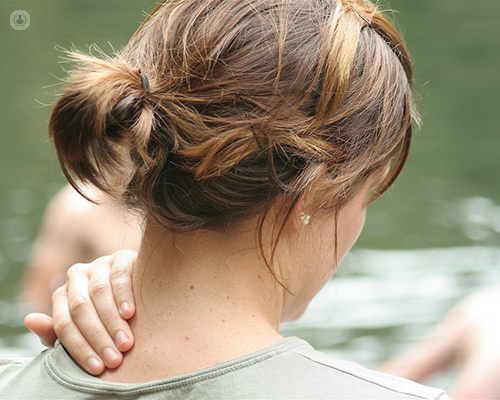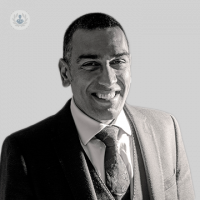Syringomyelia - how cysts on the spinal cord are treated
Written by:Syringomyelia is a fluid-filled cyst, also known as a syrinx, which develops within the spinal cord. Over time, the syrinx can get bigger and start to compress the spinal cord, causing damage. Mr Sanj Bassi, a leading neurosurgeon at the London Neurosurgery Partnership, explains the causes, symptoms, diagnosis and treatment for syringomyelia.

How does a syrinx form and why?
A syrinx forms when the cerebrospinal fluid (CSF) which circulates and protects the brain flows back on itself towards the spine, collecting tissue from the spinal cord, resulting in a small cyst. With time, fluid fills this cyst which can put pressure on the spinal cord, causing damage.
Syringomyelia can result from injury to the spinal cord, spinal tumours, meningitis and, most commonly, from a Chiari malformation. A Chiari malformation is when the bottom section of the brain protrudes into the spinal canal and obstructs the flow of CSF required.
What are the symptoms of syringomyelia?
Common symptoms of syringomyelia include:
- Headache
- Difficulty walking
- Weakness, numbness or stiffness in the backs, arms, legs and shoulders
- Pain in the neck, shoulders and face
- Signs of wasting
- Reduced sensitivity (e.g. inability to feel hot or cold)
- Bladder or bowel dysfunction
Symptoms vary between patients, but typically, the earlier symptoms will include weakness in the back, neck, arms and legs, with a loss of reflexes often presenting first.
How is syringomyelia diagnosed?
If any of the above symptoms are present, a neurosurgeon would conduct a physical examination, as well as an assessment of their medical history to check for further signs of this condition. Next, an MRI scan would be needed to assess the spine to see if there is a syrinx on the spinal cord.
How is syringomyelia treated?
Treatment of syringomyelia will depend on the severity of their condition and how much, if at all, it affects their daily life.
- Watch and wait approach:
If a patient’s syringomyelia is less disruptive with no symptoms, this approach can be taken. It involves postponing treatment until it is necessary. This is likely when the condition has been diagnosed early on and the syrinx is still small and as syringomyelia can be slow to develop, treatment is not initially required.
- Medication:
Although there is no medicine that can treat syringomyelia, they can help to relieve the symptoms experienced.
- Draining the syrinx (shunt):
A surgical procedure in which a tube is inserted to drain fluid to another part of the body, such as the abdomen to prevent the backflow of CSF onto the spinal cord.
- Surgery:
Sometimes it might be necessary to surgically remove the growth or tumour that is causing fluid to build-up on the spinal cord. For example, if the patient has a Chiari malformation, the neurosurgeon may expand the space in the spinal canal to improve the flow of CSF. Even after surgery, the syrinx can recur, so it is important to have frequent scans and follow-up appointments with your specialist. Additionally, it is important to understand that even with surgery the damage already caused by a syrinx can be permanent, so there are risks with and without having surgery.
If you are experiencing any of the above symptoms, make an appointment with an expert.


